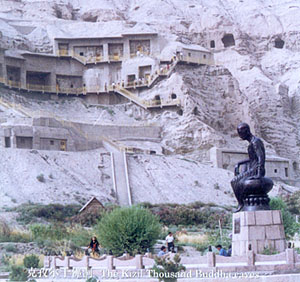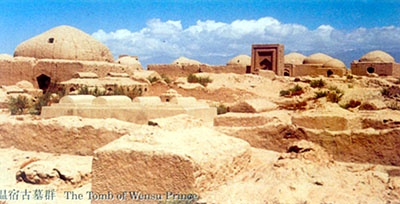|
Here are some information about Kucha
Kucha is oasis city in the Uyghur Region of . The oasis of Kucha lies at the foot of the southern slope of the Tengri Tagh (Celestial Mountains) on the northern rim of the Tarim Basin. It is watered by the Kucha River which during rainy spells flow into the Tarim River but which for most of the year lose themselves in the salt marshes on the northern edge of the Takla Makan Desert.
Kushan(Now Kucha ) Empire flourished in what is now Pakistan, Afghanistan, and northern India from about A.D. 50 to the mid-200's. The Kushan were a central Asian people, originally from Uyghur Region , who had settled in five kingdoms in what is now Afghanistan. Kujala Kadphises founded the empire by uniting these kingdoms. His successors extended the Kushan Empire into the Indus and Ganges valleys. The most famous Kushan ruler was Kanishka.
The Kushan Empire linked central Asian, Chinese, Indian, and Persian cultures and trade. Kushan emperors opened and protected the Silk Road, a major trade route for caravans carrying silk and other luxury goods from China to India and the Middle East. Cloth, spices, and medicines left Indian ports in ships bound for the Roman Empire. Rome sent back gold coins, Greek wine, and slaves.
The Kushan Empire adopted Buddhism as its official religion. Buddhist missionaries spread this religion, which started in India, throughout much of Asia. The first stone images of Buddha were created by sculptors in the towns of Gandhara and Mathura.
Kumarajiva
Associated with the city of Kucha is a famous translator Kumarajiva as briefly referred to above. His father came from India and he himself went as a youth to study in Kipin (Kashmir) and then returned to Kucha Uyghur Region . Living in this remote corner of Central Asia he was recognized as an encyclopaedia of Indian learning including a knowledge of the Vedas and "heretical sastras." After he returned to Kucha, he was converted to Mahayanism. He made his name as a great translator of Buddhist texts into Chinese.
Of the contemporaries of Kumarajiva, there are more names of great scholars who contributed to various activities of Buddhism including translation of texts into Chinese. Among them Vimalaksa, Dharmamitra, Buddhayasa and Buddhabhadra stand conspicuous. Vimalaksa was a sramana of Kubha (Kabul) and a great teacher of Vinaya in Karasher where Kumarajiva was one of his disciples. Later he, went to China in 406 and was cordially received by his pupil Kumarajiva. With his sound knowledge of Vinaya, he completed the translation of the Sarvastivadin Vinaya which Kumarajiva had at first undertaken but could not complete. His two works are Sarvastivada- Vinayanidana which still exists, constituting a part of Dasadhyaya-Vinaya, and another one which is lost. He died at the age of 77.
The oasis, which is between Aqsu and Karashahr, was an important centre on the northern branch of the Silk Road. Kucha became an important Buddhist centre; remains of this period are in the renowned Kizil caves. Many of the monks who introduced Buddhist teachings into China from the 3rd to the 7th century AD were from Kucha. The city was also famous for its musicians.
The intensively irrigated oasis produces various grains and cotton and is known for its fruit, notably pears, grapes, and melons. The city is also renowned for its handicraft cutlery industry. Pop. (mid-1980s est.) 10,000-50,000.
|
|
|
Coming Soon
Long-standing history and once prosperity of the ancient Silk Road has left Aksu with numerous historical remains and cultural legacy. The Kusan murals in the Kizil Thousand Buddha Caves and the Kumtura Thousand Buddha Caves, which were dug out in the third century AD to the fourth century AD have caused ever-increasing extensive concern from the fileds of academy and Buddhism as well as domestic and overseas tourists with their moving and weird Jataka stories, exquisite painting art and life-like group image of Buddhadharma. The Kizilgaha beacon tower, , the ancient Kusan city remain, the Ancient Tomb Comples, the Kurmish Atamushenmu garden as well as numerous mountain passes, citadels, courier stations, tombs and underthed cultural relics like strings of bright pearls are shining gorgeous luster on the ancient Silk Road.
|

